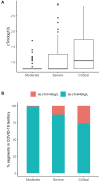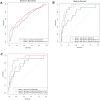Myocardial injury and COVID-19: Serum hs-cTnI level in risk stratification and the prediction of 30-day fatality in COVID-19 patients with no prior cardiovascular disease
- PMID: 32863952
- PMCID: PMC7449913
- DOI: 10.7150/thno.47980
Myocardial injury and COVID-19: Serum hs-cTnI level in risk stratification and the prediction of 30-day fatality in COVID-19 patients with no prior cardiovascular disease
Abstract
Introduction: To explore the involvement of the cardiovascular system in coronavirus disease 2019 (COVID-19), we investigated whether myocardial injury occurred in COVID-19 patients and assessed the performance of serum high-sensitivity cardiac Troponin I (hs-cTnI) levels in predicting disease severity and 30-day in-hospital fatality. Methods: We included 244 COVID-19 patients, who were admitted to Renmin Hospital of Wuhan University with no preexisting cardiovascular disease or renal dysfunction. We analyzed the data including patients' clinical characteristics, cardiac biomarkers, severity of medical conditions, and 30-day in-hospital fatality. We performed multivariable Cox regressions and the receiver operating characteristic analysis to assess the association of cardiac biomarkers on admission with disease severity and prognosis. Results: In this retrospective observational study, 11% of COVID-19 patients had increased hs-cTnI levels (>40 ng/L) on admission. Of note, serum hs-cTnI levels were positively associated with the severity of medical conditions (median [interquartile range (IQR)]: 6.00 [6.00-6.00] ng/L in 91 patients with moderate conditions, 6.00 [6.00-18.00] ng/L in 107 patients with severe conditions, and 11.00 [6.00-56.75] ng/L in 46 patients with critical conditions, P for trend=0.001). Moreover, compared with those with normal cTnI levels, patients with increased hs-cTnI levels had higher in-hospital fatality (adjusted hazard ratio [95% CI]: 4.79 [1.46-15.69]). The receiver-operating characteristic curve analysis suggested that the inclusion of hs-cTnI levels into a panel of empirical prognostic factors substantially improved the prediction performance for severe or critical conditions (area under the curve (AUC): 0.71 (95% CI: 0.65-0.78) vs. 0.65 (0.58-0.72), P=0.01), as well as for 30-day fatality (AUC: 0.91 (0.85-0.96) vs. 0.77 (0.62-0.91), P=0.04). A cutoff value of 20 ng/L of hs-cTnI level led to the best prediction to 30-day fatality. Conclusions: In COVID-19 patients with no preexisting cardiovascular disease, 11% had increased hs-cTnI levels. Besides empirical prognostic factors, serum hs-cTnI levels upon admission provided independent prediction to both the severity of the medical condition and 30-day in-hospital fatality. These findings may shed important light on the clinical management of COVID-19.
Keywords: COVID-19; Troponin I; in-hospital fatality; myocardial injury.
© The author(s).
Conflict of interest statement
Competing Interests: The authors have declared that no competing interest exists.
Figures




Similar articles
-
Longitudinal correlation of biomarkers of cardiac injury, inflammation, and coagulation to outcome in hospitalized COVID-19 patients.J Mol Cell Cardiol. 2020 Oct;147:74-87. doi: 10.1016/j.yjmcc.2020.08.008. Epub 2020 Aug 20. J Mol Cell Cardiol. 2020. PMID: 32827510 Free PMC article.
-
Myocardial injury determination improves risk stratification and predicts mortality in COVID-19 patients.Cardiol J. 2020;27(5):489-496. doi: 10.5603/CJ.a2020.0089. Epub 2020 Jun 26. Cardiol J. 2020. PMID: 32589258 Free PMC article.
-
Improvement of outcome prediction of hospitalized patients with COVID-19 by a dual marker strategy using high-sensitive cardiac troponin I and copeptin.Clin Res Cardiol. 2022 Mar;111(3):343-354. doi: 10.1007/s00392-021-01970-4. Epub 2021 Nov 15. Clin Res Cardiol. 2022. PMID: 34782921 Free PMC article.
-
Cardiac injury associated with severe disease or ICU admission and death in hospitalized patients with COVID-19: a meta-analysis and systematic review.Crit Care. 2020 Jul 28;24(1):468. doi: 10.1186/s13054-020-03183-z. Crit Care. 2020. PMID: 32723362 Free PMC article.
-
Risk factors of critical & mortal COVID-19 cases: A systematic literature review and meta-analysis.J Infect. 2020 Aug;81(2):e16-e25. doi: 10.1016/j.jinf.2020.04.021. Epub 2020 Apr 23. J Infect. 2020. PMID: 32335169 Free PMC article.
Cited by
-
The prognostic role of cardiac troponin in hospitalized COVID-19 patients.Atherosclerosis. 2021 May;325:83-88. doi: 10.1016/j.atherosclerosis.2021.04.006. Epub 2021 Apr 17. Atherosclerosis. 2021. PMID: 33910152 Free PMC article.
-
Network pharmacology and RNA-sequencing reveal the molecular mechanism of Xuebijing injection on COVID-19-induced cardiac dysfunction.Comput Biol Med. 2021 Apr;131:104293. doi: 10.1016/j.compbiomed.2021.104293. Epub 2021 Feb 22. Comput Biol Med. 2021. PMID: 33662681 Free PMC article.
-
Myocardial injuries among patients with COVID-19: a systematic review.Infez Med. 2021 Sep 10;29(3):345-354. doi: 10.53854/liim-2903-5. eCollection 2021. Infez Med. 2021. PMID: 35146339 Free PMC article. Review.
-
Coronavirus Disease 2019 as Cause of Viral Sepsis: A Systematic Review and Meta-Analysis.Crit Care Med. 2021 Dec 1;49(12):2042-2057. doi: 10.1097/CCM.0000000000005195. Crit Care Med. 2021. PMID: 34259663 Free PMC article.
-
Immune Mechanisms in Cardiovascular Diseases Associated With Viral Infection.Front Immunol. 2020 Oct 22;11:570681. doi: 10.3389/fimmu.2020.570681. eCollection 2020. Front Immunol. 2020. PMID: 33193350 Free PMC article. Review.
References
-
- World Health Organization. Coronavirus disease (COVID-19) pandemic. 2020.
-
- Novel Coronavirus Pneumonia Emergency Response Epidemiology Team. The epidemiological characteristics of an outbreak of 2019 novel coronavirus diseases (COVID-19) in China. Zhonghua Liu Xing Bing Xue Za Zhi. 2020;41:145–51. - PubMed
Publication types
MeSH terms
Substances
LinkOut - more resources
Full Text Sources
Medical
Research Materials
Miscellaneous

